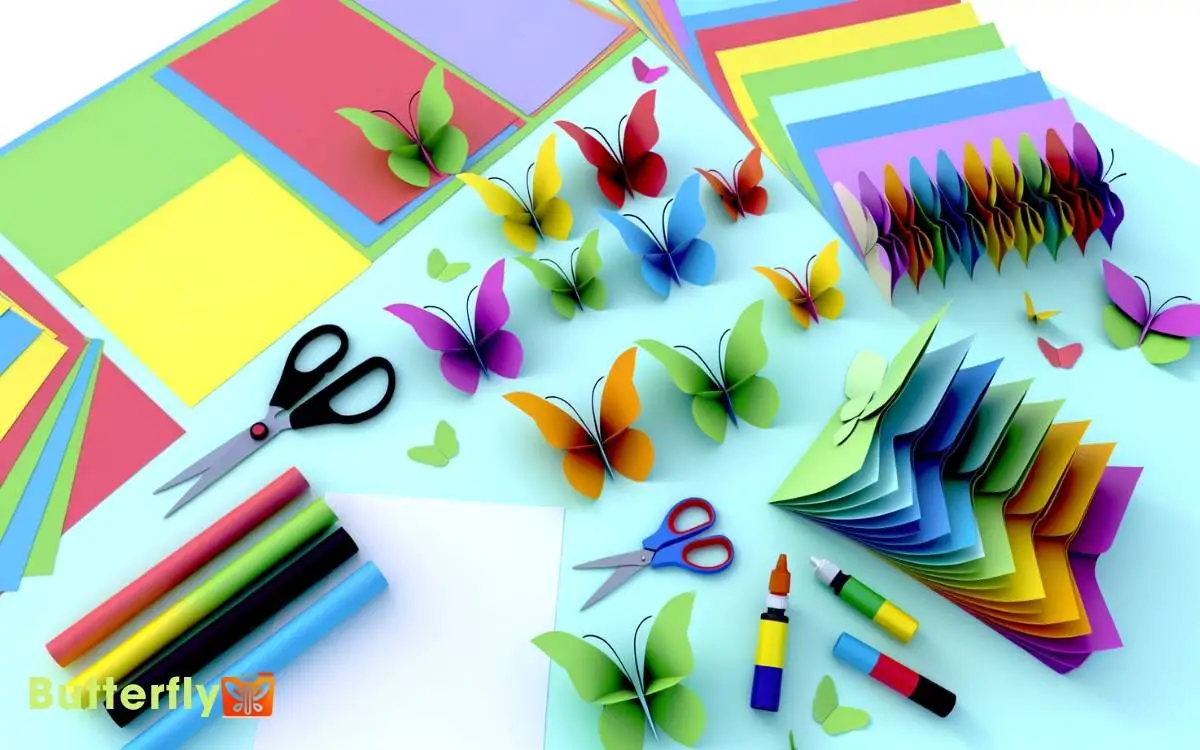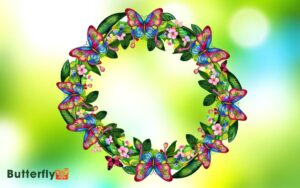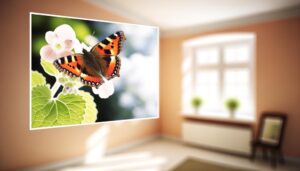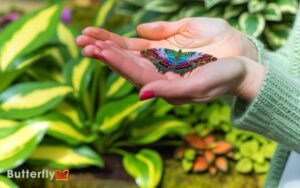How To Make 3d Butterfly? Step-by-Step Tutorial!
To craft a 3D butterfly, begin with high-quality colored paper, precision scissors, and versatile adhesive. Use CAD software to select and print templates on high-quality cardstock.
Cut out the shapes carefully with fine-tipped scissors and score fold lines lightly. Fold the wings at specific angles: lower at 20 degrees, upper at 45.
Use a bone folder for sharp creases. Align and glue body halves, smooth seams with fine-grit sandpaper, and add wire antennae.
Attach wings precisely and create realistic vein patterns using micro-beads. By following these steps, you’ll master advanced techniques for stunning 3D butterflies.

Key Takeaways
Gather Your Materials
To begin crafting your 3D butterfly, you’ll need to gather essential materials such as colored paper, scissors, adhesive, and a pencil.
Opt for high-quality, acid-free colored paper for durability and vibrant hues. Precision scissors will allow you to make intricate cuts, guaranteeing clean edges.
Choose a versatile adhesive, like a glue stick or double-sided tape, to secure seamless bonding without excess mess. A mechanical pencil is ideal for outlining your butterfly shapes without smudging.
Additionally, consider using a bone folder to create crisp, professional creases in your paper. By meticulously selecting these materials, you’ll set the foundation for a visually stunning 3D butterfly, ready to captivate with its innovative design and impeccable craftsmanship.
Choose Your Design
Begin by selecting the butterfly species that best suits your project, considering both aesthetic appeal and anatomical accuracy.
Choose a harmonious color palette that complements the species’ natural hues while adding artistic flair.
Select Butterfly Species
When selecting a butterfly species for your 3D model, consider the unique wing patterns and colors that will best showcase your design skills and artistic vision. Start by researching various species like the Monarch, Swallowtail, or Blue Morpho.
Examine high-resolution images to capture intricate details such as venation, iridescence, and edge scalloping.
Use CAD software to create precise templates, ensuring symmetry and anatomical accuracy. Pay attention to the scale and proportion of your model to maintain realism.
For added complexity, choose species with intricate patterns and textures. Don’t shy away from using advanced modeling techniques like sculpting or texturing in software like Blender or ZBrush. Your selection will greatly impact the visual impact and realism of your 3D butterfly.
Pick Color Palette
After selecting your butterfly species, focus on crafting a color palette that enhances the natural beauty and visual impact of your 3D model. Use advanced techniques to choose hues, shades, and tints that mimic or innovate upon real butterfly patterns.
Consider color theory complementary colors can make your butterfly pop, while analogous colors create harmony. Utilize digital tools like Adobe Color to experiment with different combinations.
| Color Scheme Type | Description |
|---|---|
| Complementary | Colors opposite each other on the color wheel |
| Analogous | Colors next to each other on the color wheel |
| Triadic | Three colors evenly spaced on the color wheel |
| Monochromatic | Variations in lightness and saturation of one hue |
Balance vibrancy and realism to create an unforgettable 3D butterfly.
Decide on Size
Carefully determine the scale of your 3D butterfly to guarantee it aligns with your overall design vision and functional requirements. Begin by considering the end-use and aesthetic impact.
To aid in your decision-making, follow these steps:
- Measure the intended display area: Make sure the butterfly fits proportionately without overwhelming or underwhelming the space.
- Assess material constraints: Different materials may have size limitations or ideal scales for structural integrity.
- Evaluate tooling capabilities: Your tools and machinery might limit the maximum or minimum sizes you can achieve with precision.
- Prototype in various scales: Create mock-ups in different sizes to visualize and compare their effectiveness in the intended setting.
Print the Template
- First, download the required butterfly template from a reliable source.
- Next, prepare your printing materials by selecting high-quality paper and ensuring your printer is set to the correct settings.
Download Required Butterfly Template
To get started, visit our provided link to download and print the high-resolution butterfly template essential for your 3D project.
Follow these steps to guarantee a flawless download and print:
- Access the Link: Click on the link to open the butterfly template file in your browser.
- Save the Template: Right-click on the image or file, then select ‘Save As’ to store it on your computer.
- Adjust Print Settings: Open the saved template in your preferred application and configure your print settings to ‘Best Quality.’
- Print the Template: Load the template into your printer and initiate the print command.
These steps will ensure a precise and professional template, laying a solid foundation for your innovative 3D butterfly creation.
Prepare Printing Materials
With your template printed, gather all necessary materials to guarantee a seamless assembly process for your 3D butterfly. First, select high-quality cardstock to maintain structural integrity.
Next, prepare precision cutting tools such as an X-Acto knife and self-healing cutting mat for clean, accurate cuts. Use a metal ruler for straight edges and a fine-tip pen for marking precise fold lines. Opt for a bone folder to achieve crisp, professional creases.
Additionally, have a glue stick or double-sided tape on hand for secure adhesion without added bulk. Finally, consider embellishments like metallic markers or adhesive gems for a creative touch.
Assembling these materials in advance will streamline your workflow and enhance the final product’s sophistication.
Ensure Proper Scale
Confirm the template’s scale is accurate by verifying the print settings on your computer and adjusting the scale percentage to match the desired dimensions. Precision is paramount for a flawless 3D butterfly.
Follow these steps:
- Open Print Settings: Navigate to your printer settings and locate the scale adjustment option.
- Adjust Scale Percentage: Enter the exact scale percentage needed to achieve your butterfly’s intended size.
- Preview Template: Utilize the print preview feature to make sure the dimensions align with your requirements.
- Test Print: Print a draft on regular paper to verify the scale before using your final material.
Cut Out the Shapes
After you’ve traced the butterfly template onto your chosen material, carefully use a pair of fine-tipped scissors to cut out the intricate shapes with precision.
Hold the material steady with your non-dominant hand and guarantee smooth, continuous cuts to avoid jagged edges. For intricate areas, employ a craft knife for superior control.
Rotate the material not the scissors for curved lines, to maintain accuracy. Leverage a cutting mat to protect your work surface and to facilitate clean cuts.
If using heavier materials like cardstock or thin plastic, consider scoring the lines first with a bone folder to ease the cutting process. Keep a set of tweezers handy to remove any small, stubborn pieces that might remain.
This meticulous approach guarantees professional-quality results.
Fold the Wings
- Begin by making precise creases along the wing lines to guarantee a sharp, clean fold.
- Next, fold each wing symmetrically to maintain balance and proportion in your 3D butterfly.
Precise Wing Creases
To achieve precise wing creases, align the edges of the butterfly wings meticulously and apply firm, even pressure along the fold lines.
Here’s how to refine those creases with precision:
- Pre-Fold Preparation: Lightly score the fold lines using a bone folder or stylus. This helps create a guide for a cleaner fold.
- Edge Alignment: Confirm both wings’ edges align perfectly before making the crease. Misalignment will distort symmetry.
- Pressure Application: Apply consistent pressure with your thumb and forefinger along the entire fold to avoid any irregularities.
- Crease Reinforcement: Use a ruler or the edge of a credit card to reinforce the fold, ensuring it holds its shape.
Symmetrical Wing Folding
Carefully fold each wing in half, making sure the edges align perfectly to maintain the butterfly’s symmetrical appearance. Achieve precision by using a bone folder or a similar tool to create crisp, even creases. Press firmly along the folds to ensure they hold their shape, as this will enhance the final design’s durability. For best results, refer to detailed butterfly wing DIY instructions to refine your technique and avoid common mistakes. Taking your time with each crease will contribute to a more polished and professional-looking butterfly.
Confirm that the fold line runs exactly through the wing’s midpoint to enhance structural integrity. Validate alignment by matching the edges meticulously; slight discrepancies can disrupt the overall symmetry, diminishing the 3D effect.
Utilize a ruler to verify the exactness of your folds, as even minor deviations can lead to asymmetry. Apply gentle pressure to avoid tearing the paper but ensure enough firmness to create a defined edge.
This meticulous attention to detail guarantees your butterfly’s wings maintain a professional, lifelike appearance that will captivate any observer.
Adjusting Wing Angles
Position the wings at varying angles to introduce a dynamic, lifelike posture to your 3D butterfly, guaranteeing each wing is folded at a precise degree for maximum visual impact.
- Lower Wings: Tilt them slightly downward at a 20-degree angle to simulate resting.
- Upper Wings: Angle them upward at 45 degrees to mimic a natural flight position.
- Wing Tips: Curl the tips gently using a rounded object, like a pencil, for a subtle, realistic bend.
- Central Crease: Fold a slight central crease along each wing to create depth and texture, enhancing the 3D effect.
These adjustments guarantee your butterfly not only looks realistic but also captures the essence of motion, elevating your craft to a professional level.
Assemble the Body
Begin by aligning the two halves of the butterfly’s body, ensuring the edges meet seamlessly for a professional finish. Apply a thin layer of high-strength adhesive along the inner edges to securely bond the pieces together.
Use precision clamps to hold the body in place while the adhesive cures, ensuring the structure remains stable. Employ a fine-grit sandpaper to smooth any uneven seams, creating a flawless surface.
For added realism, consider integrating fine wire into the body to simulate antennae, attaching them carefully with a minute dab of epoxy resin. This method not only adds durability but also enhances the butterfly’s intricate details.
Attach the Wings
Align the pre-cut slots on the wings with the corresponding tabs on the body, guaranteeing a snug and secure fit.
Carefully follow these steps for best results:
- Position the Wings: Hold the wings at a slight angle to the butterfly’s body. This angle facilitates easier alignment with the tabs.
- Insert the Tabs: Slide the tabs into the pre-cut slots with gentle pressure. Avoid forcing, which could damage the material.
- Secure the Fit: Once inserted, press the tabs firmly until you hear a slight click, indicating they’re locked in place.
- Stabilize the Structure: Gently wiggle the wings to ensure they’re stable. If they move too much, recheck the alignment and adjust as necessary.
Add Details
Enhance your 3D butterfly by meticulously adding intricate details that will bring it to life. Begin by using a fine-tipped embossing tool to create delicate vein patterns on the wings, mimicking real butterfly anatomy.
Next, apply thin strips of metallic wire to the edges of the wings for added structural realism. Incorporate micro-beads or tiny sequins along the wing surfaces to simulate scales and add a touch of iridescence.
Use precision tweezers to attach minuscule antennae made from flexible polymer clay. Finally, employ a magnifying glass to inspect and refine these additions, ensuring every element is seamlessly integrated.
Paint and Decorate
Transform your 3D butterfly into a vivid work of art by selecting a high-quality acrylic paint palette that captures the intricate hues and gradients found in nature. Begin by applying a base coat using a fine-tipped brush for precision.
To create depth and realism:
- Layer colors: Apply multiple layers of paint, letting each dry before adding the next.
- Blend gradients: Use a dry brush technique to blend colors smoothly, mimicking natural gradients.
- Highlight details: Add highlights to wings using metallic or iridescent paints for a lifelike shimmer.
- Add texture: Incorporate stippling and dry brushing to enhance wing patterns and textures.
Apply a Protective Coat
To safeguard your painted 3D butterfly, apply a clear, UV-resistant protective coat with a precision spray to guarantee even coverage and longevity. Begin by confirming your workspace is well-ventilated and free of dust.
Hold the spray can about 8-12 inches from the butterfly, and apply in a sweeping motion, overlapping each pass slightly. Use multiple thin layers rather than one thick coat to avoid drips and ensure a smooth finish.
Allow each layer to dry completely before applying the next, following the manufacturer’s drying times. This technique not only protects the paint but also enhances the vibrancy and detail of your butterfly.
Mounting Options
When deciding how to display your 3D butterfly, consider various mounting options that best highlight its intricate details and vibrant colors.
Here are some advanced techniques to elevate your presentation:
- Shadow Box: Create depth by placing the butterfly in a shadow box, using a contrasting background to make colors pop.
- Float Mount: Achieve a modern aesthetic by suspending the butterfly between two panes of glass, giving it a floating effect.
- Wire Mount: Use thin, nearly invisible wires to suspend the butterfly in mid-air, emphasizing its delicate structure.
- Pin Mount: Secure the butterfly on a fabric-covered board with entomology pins, ensuring a museum-quality display.
Each method offers a unique way to showcase your artistic creation, enhancing its visual impact and professional presentation.
Display Ideas
Elevate your 3D butterfly display by experimenting with creative arrangements that enhance its natural beauty and craftsmanship. Begin by curating a shadow box with a contrasting backdrop to make the colors pop.
Arrange your butterflies in a dynamic flight pattern for a sense of movement. Utilize glass domes to create a 360-degree view, allowing light to play off their wings.
For an avant-garde approach, suspend butterflies from thin, transparent threads at varying heights to simulate a fluttering swarm. Consider integrating LED lighting to spotlight specific areas, creating dramatic shadows and highlights.
Final Touches
Apply a clear gloss finish to your 3D butterflies to enhance their vibrancy and protect their delicate details.
Follow these steps for a flawless application:
- Clean: Gently dust off the butterfly with a soft brush to remove any particles.
- Apply: Use an airbrush or fine spray bottle to apply an even coat of clear gloss varnish. This guarantees a smooth, polished look.
- Dry: Allow the butterflies to dry in a dust-free environment, preventing any imperfections.
- Inspect: Examine your butterflies under good lighting to confirm an even finish and touch up any missed spots if necessary.
These meticulous steps will provide a professional, innovative touch to your 3D butterfly creations, ensuring they stand out in any display.
Conclusion
Congratulations, you’ve created a stunning 3D butterfly! Like a delicate piece of origami art, your butterfly is ready to take flight in any display you choose. Guarantee every fold and cut is precise, and don’t forget the protective coat for longevity.
Whether you mount it on a wall or let it hover in a shadow box, your creation will surely captivate. Add those final touches to elevate its beauty, making it a true masterpiece.






